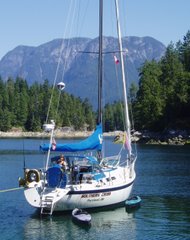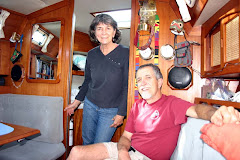
So the next stop was the bank. There is an ATM, but it only dispenses bills that are worth about US$100 and are hard to get changed, so after getting a withdrawal from the ATM, we stood in line at the teller to get smaller bills. There was only one teller, and several yachts were posting their bond (amount equivalent to airfare to your home country, to insure that you don't try to overstay your welcome in Polynesia), so it was about a 30 minute wait. With our new francs burning a hole in our pockets, we headed for the Make Make snack bar for burgers and beer. A shared burger platter and a beer apiece set us back US$28!!! After our first and probably last meal out, it was back to the store while we could still afford to buy something other than baguettes. The rain continued to fall heavily, so we were very happy to run into Sondra, who offered us a ride back to the harbor. We spent the rest of the day watching it rain. The guidebook has a graph that says the average rainfall for the month of April is 4 inches. We probably got close to that much today!
Tuesday morning, we bailed out the dinghy, raised the anchor, and made a 40-mile-long upwind passage to Fatu Hiva, motorsailing the entire day. Fatu Hiva is the most remote inhabited island in the Marquesas, and the most traditional in terms of lifestyle. The only way to get here is by boat (there are several cruise ships that call in about 3x/year). Josh was particularly eager to meet up with two other boats with kids his age that we knew were already in Fatu Hiva.
It was a long rough passage, but as we neared the island, we came into its lee, and we could appreciate the magnificent vista. The afternoon sun illuminated steep, striated, heavily vegetated volcanic cliffs (similar to Na Pali on Kauai), and the masts of the 4 sailboats already anchored at Hanavave. We arrived just in time to get the anchor set before the sun set. 
Before we could even sit down to dinner, we were invited to one of the other boats for a "seminar" on the anchorages of the Marquesas and Tuamotus, offered by a German sailor who has made 5 previous trips through these islands. Tons of great info, and a great opportunity to meet the other sailors. Tommy and Fiona invited us to join them and their 3 kids for a 10-mile hike across the island to the one other town, Omoa.
Wednesday we got up early and packed for the all-day hike. We had 12 people from 3 yachts: Evergreen, Phambili, and Calou. A boat ride back from the other village would have cost more than $200, so John from Calou generously agreed to bring two dinghies over to Omoa in the afternoon to retrieve us. We got to shore before the other boats, so Vicki and I strolled into the small village of Hanavave. I tried out my Polynesian greeting on the first local woman I met: "ia orana." I could tell by the length and tone of her reply that I had committed some sort of faux pas. The next person I met was Daniel. He kindly listened to my fractured French questions, and explained that the Marquesan language is different from Tahitian. "Hello" here is "kaoha". Armed with the proper greeting, we now got a warm smile from everyone else we met!
Soon the rest of the group marched up from the small harbor, and we were off on our hike. Vicki and I stopped to take lots of pictures and were soon trailing the rest. A couple of local men asked if we were going to the waterfall (a much shorter hike) and we said, no, we were headed to Omoa. They looked at us like we were a bit daft, which should have been a clue.
We were surprised that the concrete road continued beyond the edge of town and started switchbacking up the steep mountainside. The French have invested a lot in basic infrastructure, even on this most remote of the islands (it is amazing what a country can afford to do when its budget is not dominated by military spending). We stopped and filled our water bottles at a pure mountain spring bubbling out of the hillside, and continued trudging up the steep road until we reached a spectacular viewpoint over the village and the sea. The concrete soon ran out and we were now walking a dirt road. Tommy and Fiona told us that they had done this walk 17 years ago on their first voyage across the Pacific, and at that time there was nothing here but a footpath.
As we had ascended to the level of the bottom of the clouds, it was not too surprising when we started feeling a light rain. The cooling effect was welcome. The only disappointment was that we had not brought our waterproof camera, so photos were limited to lulls in the rain. Onward and upward we went, until we had left the original valley far behind and were traversing a series of ridges. The vegetation was somewhat reminiscent of Scottish moorlands, except that in some places the grasses and low shrubs were supplanted with a variety of tropical trees. Orchids bloomed along the roadside in several places.
We finally reached a tin-roofed shelter with a picnic table underneath, at about the same time that the rain stopped. Everyone was still in high spirits, but that was about to change. After we finished eating and started downhill for the first time, the rain came on again, lightly at first, then harder, and eventually we were being pummeled by some of the most torrential rain I've ever seen. Though the temperature was still in the 80s, I think we could have actually gotten hypothermic had we not been hiking. Most of the group were wearing running shoes and socks. Vicki and I had on Chacos, and these were far better suited to the conditions - deep puddles, oozing mud, and red torrents of muddy water. The forest along this part of the trail was incredible - enormous mango trees and a huge variety of other unfamiliar species.
Finally the storm spent itself and we reached the concrete again, which told us Omoa was not far off. When we had descended below the clouds, a cruise ship could be seen anchored out to sea. Once in town, we found baguettes, beer, and a number of inquisitive cruise ship passengers wondering how in the world we had managed to become so filthy and sodden! We were glad to find John waiting with the dinghies. After a quick tour of town, we loaded up and made the 3-mile return trip to Hanavave by sea.


No comments:
Post a Comment